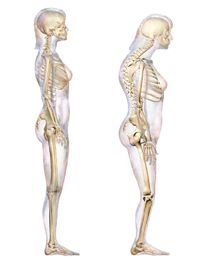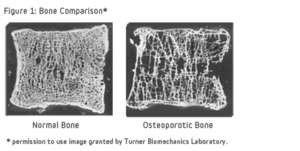Ageing and the Locomotor System
Original Editor - User Name
Top Contributors - Simisola Ajeyalemi, Lucinda hampton, Kim Jackson and Rucha Gadgil
Introduction[edit | edit source]
The locomotor system is also known as the musculoskeletal system.
- It is made up of the skeleton, skeletal muscles, ligaments, tendons, joints, cartilage and other connective tissue.
- These parts work together to allow your body to move.
Changes in the locomotor system with ageing can include:
Loss of muscle bulk, degenerative joint changes and a decline in physical strength.
Disability: as a combined effect of muscular weakness, joint stiffness and impaired central mechanism for sensorimotor performance.
Stooped posture, loss of height, atrophy and weakness in skeleton and major muscle groups: result in a more flexed, tired posture with altered biomechanics, muscle imbalance, and slowly decreasing range in joints and overall decrease in safety.
Posture[edit | edit source]
Stooped posture, loss of height, other distortions owing to atrophy and effect of weakness in skeleton and major muscle groups become responsible for posture and antigravity support. The result is a more flexed, tired posture with altered biomechanics, muscle imbalance, and slowly decreasing range in joints and overall decrease in safety. The therapist may have to provide walking aids and order a wheelchair for the person if necessary.
Sarcopenia[edit | edit source]
Sarcopenia is defined as being a decline in muscle function (either walking speed or grip strength) associated with loss of muscle mass[1]. Sarcopenia most commonly affects elderly and sedentary populations and patients who have comorbidities that affect the musculoskeletal system or impair physical activity[2]. Sarcopenia leads to disability, falls, and increased mortality. Loss of muscle strength and aerobic function are 2 of the hallmarks of frailty. Sarcopenia has been linked to an increased prevalence of osteoporosis, thus further increasing its propensity to produce fractures
Bones[edit | edit source]
Osteoporosis is a major public health problem affecting millions of elderly individuals. Besides causing fractures, the disorder leads to severe psychosocial and financial consequences for the patient. The condition has many risk factors and is best managed by an interprofessional team of healthcare workers[3].
By 60–70 years, skeletal mass may be reduced to half of that at age 30.
- If dietary intake of vitamins and calcium is poor, this will increase the problem.
- Osteoporosis increases the risk of fracture. This can lead to later issues with range in the joint and mobility of the muscle[4].
Effects of Ageing on Joints[edit | edit source]
No matter how healthy an individual is, as they age their joints will show some changes in mobility, due in part to changes in the connective tissues. As joint range of movement has a direct effect on posture and movement, this can result in marked alteration of function.
By age 65, 80% of the population has some articular disorder
eg Loss of resilience and elasticity in ligaments, cartilage and periarticular tissues; degeneration with erosion, and calcification of cartilage and capsule; gradual reduction in collagen but not in the water content.
Bunions, subluxation of small joints in hands and feet are common, as are painful feet and other chiropody problems.
Proprioception and general sensation may be decreased if changes to muscle and joints are compounded by nerve damage.
Loss of muscle bulk, degenerative joint changes and a decline in physical strength cause limitation of range and speed of movement. Disability ensues as a combined effect of muscular weakness, joint stiffness and impaired central mechanism for sensorimotor performance, so there is:
- Less precision in fine movements and in rapid alternating movements
- Irregular timing of action, loss of smooth flow of one form of action into another
- Slowing down to avoid outcome of one action before planning the next. Confidence and reliability of action may be reduced. The individual may experience difficulty with intricate tasks (worse if complicated by uncompensated visual defect).
Treatment[edit | edit source]
Many older adults respond well to treatments such as heat, ice or massage before beginning an exercise regime. Prolonged rest and periods of non-weight bearing will weaken bone and muscles so do not allow the person to lay idle in bed unless you are specifically told not to intervene. A similar problem can be seen in pathologies such as arthritis, osteoporosis and recurrent falls, where the problem is often compounded by the person’s own fear of further injury if they do too much. Take time to educate individuals properly about their condition as it often ensures their participation in a session, as opposed to resistance
Resources[edit | edit source]
Ageing and the Locomotor System
References[edit | edit source]
- ↑ Malmstrom TK, Morley JE. SARC-F: a simple questionnaire to rapidly diagnose sarcopenia. Journal of the American Medical Directors Association. 2013 Aug 1;14(8):531-2.Available from: https://www.researchgate.net/publication/243966215_SARC-
- ↑ Ardeljan AD, Hurezeanu R. Sarcopenia. StatPearls [Internet]. 2020 Jul 10. Available from:https://www.ncbi.nlm.nih.gov/books/NBK560813/ (accessed 9.3.2021)
- ↑ Joann L. Porter; Matthew Varacallo 19.12.2019 Osteoporosis Available from:https://www.ncbi.nlm.nih.gov/books/NBK441901/ (last accessed 27.2.2020)
- ↑ Ageing_locomotor_system.pdf








